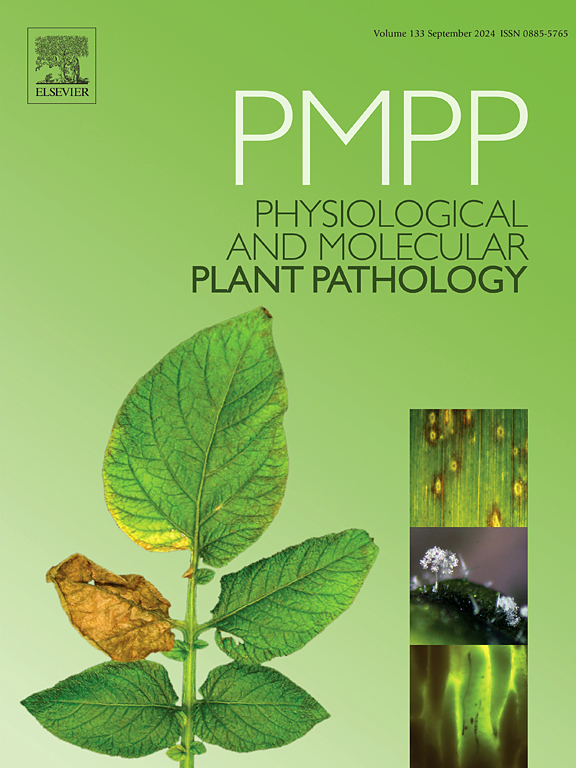Understanding resistance mechanisms and impact of begomoviruses on pumpkin: A morphological, histopathological, and biochemical perspective
IF 3.3
3区 农林科学
Q2 PLANT SCIENCES
引用次数: 0
Abstract
Begomoviruses significantly threaten pumpkin production in tropical and sub-tropical regions, exhibiting yellow vein and leaf curl symptoms resulting in stunted growth and complete yield loss. This study characterizes the virus(es) associated with these prevalent symptoms and identify resistant mechanisms by investigating the impact of begomoviruses on morphological, histopathological and biochemical changes in resistant and susceptible genotypes. Molecular characterization revealed the predominance of squash leaf curl China virus (SLCCNV) and tomato leaf curl New Delhi virus (ToLCNDV) in infected sample. Whitefly-mediated artificial screening of twenty-five pumpkin genotypes against SLCCNV and ToLCNDV identified Punjab Nawab as resistant, while Punjab Samrat as susceptible genotypes. Histopathological evaluations of uninoculated and inoculated (SLCCNV and ToLCNDV) plants of Punjab Nawab revealed minimum ultrastructural changes among dermal, ground and vascular tissues. Contrarily, inoculated plants of Punjab Samrat showed severe vascular tissue damage in leaf, petiole and stem, with ToLCNDV causing more pronounced tissue distortion. Biochemical analysis too indicated increased levels of PO (Peroxidase assay), TAL (Tyrosine ammonia-lyase assay), PAL (Phenylalanine ammonia-lyase assay) and SOD (Superoxide Dismutase Assay) in both genotypes on inoculation. SLCCNV infected plants showed greater decline in photosynthetic pigments compared to ToLCNDV. The rise in total phenol content confirmed an active defense mechanism in inoculated plants against viral infection. Furthermore, correlation and heatmap analysis confirmed that Punjab Nawab exhibited increased enzymatic activity and minimal chlorophyll loss upon virus inoculation. Therefore, Punjab Nawab is a valuable genetic resource for introgressing begomovirus resistance into elite pumpkin cultivars which increases adaptability and yield stability across diverse agro-climatic regions.
从形态、组织病理学和生化的角度了解南瓜对begomovirus的抗性机制和影响
在热带和亚热带地区,begomovirus严重威胁南瓜生产,表现出黄脉和叶片卷曲症状,导致生长发育迟缓和产量完全损失。本研究通过调查begomovirus对耐药和易感基因型的形态学、组织病理学和生化变化的影响,确定了与这些流行症状相关的病毒的特征,并确定了耐药机制。分子鉴定结果表明,侵染样品中存在南瓜卷叶中国病毒(SLCCNV)和番茄卷叶新德里病毒(ToLCNDV)。用白蛉介导的25个南瓜基因型对SLCCNV和ToLCNDV进行人工筛选,发现旁遮普Nawab为抗性基因型,而旁遮普Samrat为敏感基因型。旁遮普Nawab未接种和接种(SLCCNV和ToLCNDV)植株的组织病理学评价显示,表皮、地面和维管组织的超微结构变化最小。而接种后的旁遮普Samrat叶片、叶柄和茎维管组织损伤严重,其中ToLCNDV造成的组织畸变更为明显。生化分析也表明,接种后两种基因型的PO(过氧化物酶测定)、TAL(酪氨酸解氨酶测定)、PAL(苯丙氨酸解氨酶测定)和SOD(超氧化物歧化酶测定)水平均有所升高。与ToLCNDV相比,SLCCNV感染植株的光合色素下降幅度更大。总酚含量的增加证实了接种植株对病毒感染的主动防御机制。此外,相关分析和热图分析证实,接种病毒后,旁遮普纳瓦布的酶活性增加,叶绿素损失最小。因此,旁遮普Nawab是一种宝贵的遗传资源,可以将抗begomovirus的基因渗入到优质南瓜品种中,从而提高南瓜在不同农业气候区域的适应性和产量稳定性。
本文章由计算机程序翻译,如有差异,请以英文原文为准。
求助全文
约1分钟内获得全文
求助全文
来源期刊
CiteScore
4.30
自引率
7.40%
发文量
130
审稿时长
38 days
期刊介绍:
Physiological and Molecular Plant Pathology provides an International forum for original research papers, reviews, and commentaries on all aspects of the molecular biology, biochemistry, physiology, histology and cytology, genetics and evolution of plant-microbe interactions.
Papers on all kinds of infective pathogen, including viruses, prokaryotes, fungi, and nematodes, as well as mutualistic organisms such as Rhizobium and mycorrhyzal fungi, are acceptable as long as they have a bearing on the interaction between pathogen and plant.

 求助内容:
求助内容: 应助结果提醒方式:
应助结果提醒方式:


